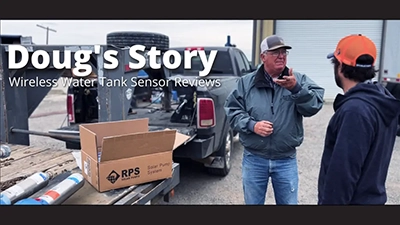Wire Splicing for a Well Pump
Part 3 of our installation series demonstrates the proper methods to splice electrical wires for your Solar Well Pump or other DIY project.
in this next section we’re going to give you an overview of the wiring of your system the first part we’re going to show you how to splice your pump wire to your drop wire we’re also going to show you how to hook up your electrical sensors and splice those if needed and then finally we’ll talk about hooking up your solar panels to your controller using your extension wires
we’ve been told that splicing the pump wire is one of the most difficult parts of this installation we think it’s pretty easy and so if that’s the most difficult part you should have no problem we’re gonna walk through the various steps of the splice so all of our pump cable comes with around 15 feet of wire off the end for most of the installations you’re going to need to add your own wire in order to stand the length of it what you’re looking for is three strand submersible wire between 14 and 10 gauge depending on your installation length it is PVC jacketed to make it waterproof and robust against chafing in the well casing we’re going to start by preparing our pump wire as you can see we have our three strands of wire coming out and each one has a number on it one two and three two of the wires are already stripped and we’re going to strip off insulation of the third wire one thing you’ll notice about this wire is it is cut at different lengths doesn’t matter which one is which but we have one short one medium one long what this is going to do is when we do our splice on the end of it it results in a bulge in the wire and that way all the bulges don’t line up in the same spot and it’s easy to shrink the tubing over the top of it next we prepare our drop wire we’re going to very something very similar first we’re gonna remove the outside jacketing using a razor blade now gonna be very careful you want to cut just through the outside layer and not Knick the insulation on the inside of the wire if you take your time you can get a nice clean cut on the outside jacket without damaging any of the wires within
a lot of wire comes with another inside layer that can also be removed which leaves us with our three strands exposed a lot of people ask why is this a DC pump with three wires well since it’s a brushless motor it actually has three phases within the motor and that means we need three wires one for each of the phases going down to the motor from here we want to match up our wires we have a black wire we have our brown / red wire and we have our blue wire what we want to do is butt them up end to end and then cut the lengths so they end up exactly the same length the closer you can get these wires together the better will be for your splicing in the long run where the three wires exposed we want to butt them up and line them up with our pump wire since the black wires are shortest we don’t need to cut it we can line up our red wire and cut it with our wire cutters again overlapping the black wire the proper distance we can line up our blue wire and cut our blue wire as you can see pretty closely the wires are lying and when we strip them and then crimp them together there’ll be a nice straight connection using our wire strippers again we’ll strip off outside jacket
and now we’re ready to start the crimping process all of our pumps come with our crimp kit I can open it up and pull out the shrink tubing and the butt crimps using our shrink tubing we can make sure we have enough length on a wire so we can slide the shrink tube all the way on the wire while we’re doing our splice in this case I think I cut it a little short so we’re going to go a little bit further down the wire we like double installation in case one layer fails you have a backup layer protecting your electrical connections we’ll slide the large shrink tube over your drop wire and then we’ll slide the small shrink tubing over each of your three strands
there’s a couple of different tools you can use for crimping your wires we have our standard electrician pliers and we also have a crimper design for crimping butt splices put our butt crimp over the end of the wire and then using the appropriate location on the crimpers we’re going to crimp this down
as you can see if we use the pliers in the right location a very strong crimp and it’s not going to come off we’ll continue to do the same thing for the other two wires one tip that’s kind of hard to see is I do like the indentation of the crimpers to end up on the backside of the crimp where the seam is not located that prevents the scene from opening up and making it more difficult to crimp your wire now we have the crimps onto our drop wire and we’re going to crimp onto our pomp wire sometimes it’s easier to hold everything together if you insert the butt splice into your pliers first and then do your crimping I am doing two crimps per butt splice in this case in order to make sure we have a nice tight electrical connection
when we went to our red wire and finally will crimp our blue wire this is your last chance you want to make sure everything’s connected nice and tightly next we’re gonna slide the shrink tubing that you previously put onto your wires over the butt splice this is adhesive line shrink tubing which means there’s an adhesive layer on the internal side of the shrink tubing and when it heats up that adhesive layer is going to melt and it’s gonna really seal around that wire giving us a waterproof connection where we recommend is the night before in the shop to do this splice and take the time in order to get a nice waterproof connection we like using a heat gun a heat gun is going to give you nice even heat around your wire and your shrink tubing and it’s gonna melt that internal adhesive and make sure it seals up really tightly around the wire but like most of our customers they’re out in the middle of the field and one of the reasons they’re using solar is because they don’t have electricity at the site in that case either a torch or butane lighter can be used is that to be a lot more careful as you evenly heat the shrink tubing around all sides and make sure you don’t burn it so using a butane lighter we can evenly heat one side and then around the other side in order to make our connection
take your time as you don’t want to burn the shrink tubing or the wire or else you’re gonna have to start over here we have a nice connection you can see there’s a very small amount of he Civ flowing out of the end of the shrink tubing the rest of these I’m going to use the heat gun and make you go a little faster with a setting on high we can nice and evenly heat the shrink tubing on all sides ensuring a waterproof connection
there we go so this looks really good as you can see the shrink tubing has squeezed down around that wire and that butt crimp we can see the indentation of the butt crimp inside and also on the very edges you can see we have adhesive squeezing out of that and I shrink tubing that’s exactly what we want to see what that means is the adhesive is melted and it’s sealed both the shrink tubing and the wire together so no water can get into that connection next we’re gonna put our outer layer shrink tubing over the whole connection but this is really important you don’t want to forget this you either want to write down the numbers of your wire that one is black that two is blue and that three is brown / red or you can use the provided numbers in order to relay all your wire we’ll do that real quick here we’re going to grab the other end of our wire and again we’re gonna take off this outside jacket without side jacket removed we can relay where our wires we know black is one you know blue is two
and red is three there’s a very simple but important step what happens is if you mix up these wires and you hook it up to the controller then the pump is gonna run backwards and you’re gonna be trying to shoot an install with a pump down in the well which makes it much more difficult so with our wires labeled we can move on to our final heat shrink application we’ll take our big tube and we will slide it right over so those crimps are roughly right in the center again you can use your lighter it’s gonna take a while as you slowly heat up the entire shrink tube you have a butane torch that’s gonna make this whole process go a lot faster on the field or if you plan ahead you can do it the night before in the shop with your econ
as you do in the heating you want to take your time and slowly work your way around the shrink tubing in order to heat it evenly which in turn melts the internal adhesive it allows it to flow encasing the wire your other shrink tubing and your butt crimps in an extra layer of adhesive and shrink tube
with the shrinking done we have a nice tight waterproof connection again we’ll take a quick look at the end of the cable you can see there’s a little bit of adhesive that squeezed out that’s exactly what you want to see
you
Are you looking for a solar pump?
RPS is a family-owned company of laser-focused mechanical, electrical and software engineers that live and breathe solar pumping almost every hour of every day. We have sales offices in a number of states now, but our main shop has moved to an Ag town in California (we do get poked fun of for this!) and our warehouse to move there shortly. We put great time, money and thought into our kits – including parts and components to make installation a breeze. Our reading materials, manuals, videos and diagrams allow customers of all skill levels to install a solar pump successfully the first time. As has become famous, we also offer a direct line to talk with real humans! ..our actual pump engineers for asking questions, helping troubleshoot, or planning for installation.


